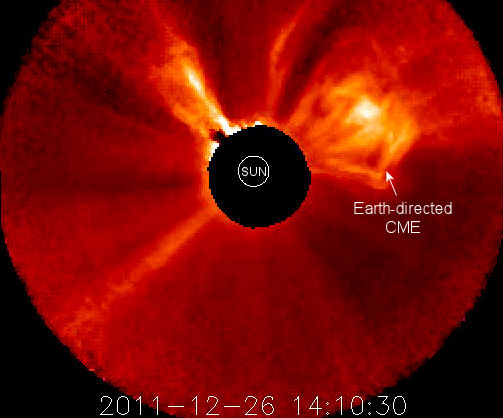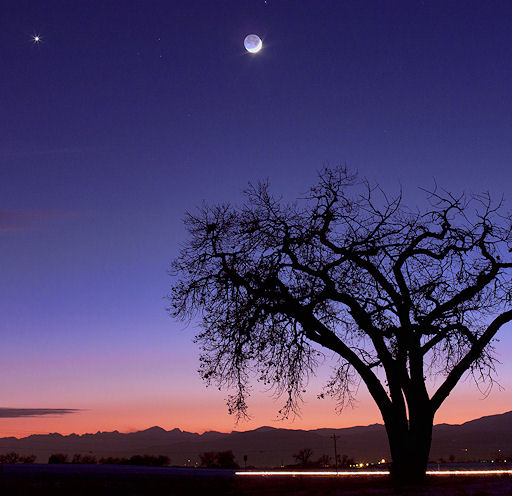~Space Weather Update~ Two CMEs toward Earth in less than 24 hours.
MORE SUNSET PLANETS: On Dec. 27th, for the second night in a row, Venus and the crescent Moon are lining up in the western sky for a beautiful sunset conjunction. Go outside when the sun goes down and enjoy the show. (Scroll past the CME for scenes from Dec. 26th.)
CMEs TARGET EARTH, MARS: The odds of a geomagnetic storm on Dec. 28th are improving with the launch of two CMEs toward Earth in less than 24 hours. NASA's STEREO-B spacecraft photographed this one on Dec. 26th:
According to a forecast track prepared by analysts at the Goddard Space Weather Lab, the cloud should squarely strike Earth's magnetic field on Dec. 28th at 20:22 UT (+/- 7 hours). Another CME could deliver a glancing blow a few hours earlier on the same date. The double impact is expected to spark mild-to-moderate geomagnetic storms at high latitudes. Aurora alerts: text, voice.
Mars is also in the line of fire. The first of the two CMEs is squarely directed toward the Red Planet--estimated time of arrival: Dec. 30th at 1800 UT. Using onboard radiation sensors, NASA's Curiosity rover might be able to sense the CME when it passes the rover's spacecraft en route to Mars.
VENUS AND THE MOON: On the night after Christmas, the heavens delivered a belated present--a conjunction of Venus and the crescent Moon. Robert Arn sends this picture from Fort Collins, Colorado:
"I arrived at the observing site a few minutes before sunset," says Arn. "Minutes after the sun disappeared behind the mountains I saw a very slender moon pop out of the cold, crisp sky. Soon, Venus joined the show. Over the next two hours I watched the sky turn hundreds of shades of blues, pinks, purples, and blacks as the two heavenly bodies slowly crept across the sky."

![]()
Solar wind
speed: 243.3 km/sec
density: 0.7 protons/cm3
explanation | more data
Updated: Today at 1426 UT
![]()
X-ray Solar Flares
6-hr max: C6 1207 UT Dec27
24-hr: C8 0422 UT Dec27
explanation | more data
Updated: Today at: 1400 UT
![]()
![]()
![]()
Daily Sun: 27 Dec 11
![]()
![]()
Sunspots 1386 and 1387 have "beta-gamma" magnetic fields that harbor energy for M-class solar flares. Credit: SDO/HMI
![]()
![]()
![]()
Sunspot number: 110
What is the sunspot number?
Updated 26 Dec 2011
Spotless Days
Current Stretch: 0 days
2011 total: 2 days (<1%)
2010 total: 51 days (14%)
2009 total: 260 days (71%)
Since 2004: 821 days
Typical Solar Min: 486 days
Updated 26 Dec 2011
The Radio Sun
10.7 cm flux: 146 sfu
explanation | more data
Updated 26 Dec 2011
![]()
![]()
![]()
Current Auroral Oval:
![]()
Switch to: Europe, USA, New Zealand, Antarctica
Credit: NOAA/POES
![]()
![]()
![]()
Planetary K-index
Now: Kp= 0 quiet
24-hr max: Kp= 0 quiet
explanation | more data
![]()
Interplanetary Mag. Field
Btotal: 3.3 nT
Bz: 2.5 nT north
explanation | more data
Updated: Today at 1426 UT
![]()
![]()
![]()
Coronal Holes: 27 Dec 11
![]()
![]()
A solar wind stream flowing from this coronal hole could reach Earth between Dec. 29th and 30th. Credit: SDO/AIA.






